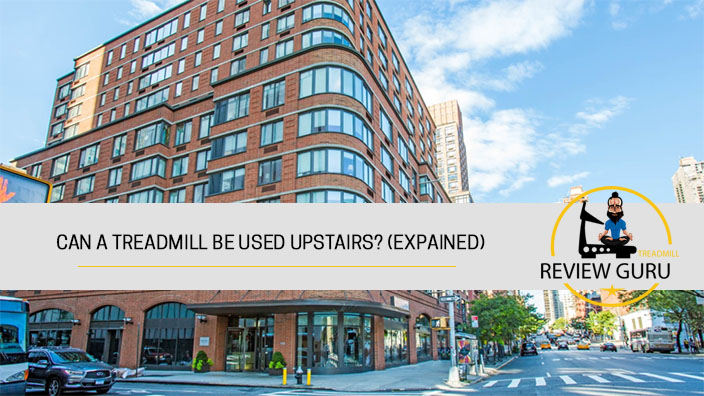A home treadmill is one of the best home gym investments you can possibly make in your health and fitness. Instead of going to the gym, you can burn calories at home. And since you don’t have to go to the gym, it won’t be as easy to talk yourself out of exercising because it’s cold outside or your car’s low on gas or because chips are delicious. Plus, working out at home means you won’t get overcharged for a protein shake when you feel like you need a snack after your gym workout.
But unless you live in an actual gym or own your home with plenty of space from nosy neighbors, you may have some concerns about bringing a treadmill home. Treadmills can be seriously heavy pieces of equipment, and many treadmills—and treadmill runners—can be very noisy.
Besides the obvious hassle of getting this beast of a machine set up, what if your floor won’t take the weight? Treadmill Guru is here to help answer all these questions and assist you in deciding if bringing a treadmill home is right for you.
Is it Safe to Use Treadmill Upstairs?

The answer to this question is going to depend on many different factors. But for the most part, in a building that is structurally sound, the floors should easily be able to take the weight of both a treadmill and the person on top of it.
The heaviest residential treadmills out there generally reach about 350 lbs, though some like the Peloton Tread weigh up to 455 lbs. So, if we put a 300-lb person on top of the average treadmill that weighs 350 lbs, that’s a combined weight of 650 pounds. While that may sound like a lot, buildings that are up to code should be able to take that weight without an issue.
-
How Much Weight Can Your Floor Take?
Again, it will depend on the construction of the building you live in. But a properly built floor should easily support 50 lbs per square foot. So in a room that’s 100 square feet, that’s 5,000 lbs of weight needed before you risk structural damage! So, you don’t need to worry about suddenly crashing uninvited into your downstairs neighbor’s dinner party.
If you’re still concerned, there are a few things you can try to mitigate any risk. If you know the building well, you could set the treadmill down directly on top of a floor joist for added weight-bearing capacity. Or, if it’s the upper floor of a house we’re talking about, you could position the treadmill above a load-bearing wall. Another option is to look for a lighter treadmill. Again, it’s very unlikely that even the most massive treadmill is going to be too much for your floor to take, whether you live in a house or an apartment. But lighter models are easier to move into position. Besides, you don’t want to feel nervous every time you use your treadmill. As far as excuses not to exercise, you have to admit that saying, ‘I’m scared of falling through the floor’ is at least fairly original, but it’s not going to help you shed those unwanted pounds.
Some Common Upstairs Treadmill Problems And Their Solutions

Unless you live in the most flimsily constructed of shacks, you shouldn’t have to worry about your treadmill crashing through the floor. But that doesn’t necessarily mean that’s the only problem that comes with keeping a treadmill upstairs. First, you need to think about noise and vibrations.
Most of the sound we hear reaches us through the air. But the air is a relatively poor conductor of sound waves. Solid objects can carry sound both quicker and more forcefully than air does. What sounds moderately loud to you can be deafening to others elsewhere in a building.
Treadmills can generate a lot of vibration when in use, and vibration means noise. If someone is on the floor below you, there’s practically no way they’re not going to hear you exercise.
Before you set up a treadmill on an upper floor of your house, it’s a good idea to test the way sound carries in the building. You can do this by standing on your tiptoes upstairs, and dropping your heels to the floor. Have a friend on the floor below listen. If they can hear the sound of your heels hitting the floor, the noise of a treadmill will most likely be very loud. A carpeted floor can help mitigate the noise, and anti-vibration treadmill mats are available, which can both cut down on noise and protect floors from damage. Also, positioning the treadmill in a corner can help cut down on the vibrations as the walls absorb the vibration and some of the noise.
-
When Using A Treadmill In a Condo or Apartment
Having a treadmill on the upper floor of a house can cause problems. But at least you can talk it over with the other members of your household. Apartment buildings can be a different story.
The vibrations generated by a treadmill will spread throughout a building, amplified by wall voids and wooden framing. A treadmill that runs at, say 50 decibels can produce 100 decibels of noise for anyone below you. That’s close to the sound of a train passing by, which hey if you live near train tracks, problem solved! But, since that’s not normally the case, there may be other steps you need to take.
With these considerations, it’s not unusual for treadmills to be banned in apartment buildings, or at least highly discouraged. Even where they’re not explicitly forbidden, you should tread carefully and see what you can do to reduce the noise and vibrations that your treadmill produce.
If possible, you should move to the first floor of your apartment complex, as it avoids the issue of noise to the neighbors below and it’s far less difficult to get a treadmill in and out. Or honestly, you could look for an apartment with a gym or fitness center facility. However, this feature often raises the price of the apartment overall, so it may be cheaper to just buy a treadmill. Moreover, if you don’t want to leave your place, you can try treadmill mats, gypcrete soundproofing and other kinds of noise reducers to ease the thud sounds and to eliminate the vibrations. Talk to your downstairs neighbors and say, “I will sometimes be working out on my treadmill during the day. If the noise ever bothers you, please come up and knock to let me know!”. Also, ask them what would be a good time so that you don’t bother them and see if you can find a time when the vibrations from your workout won’t disturb them. Maybe there are some hours when they aren’t home, and you could schedule your treadmill workouts for those times. Asking your neighbors about good workout times is a good thing to do. In this way, your neighbors might feel more comfortable approaching you if you are making too much noise at the wrong times and far less likely to complain to management. Just a bit of consideration can go a long way in making relations between you and your neighbors comfortable as you pound away on your treadmill.
Getting A Treadmill Upstairs: Most of the companies won’t deliver a treadmill past the curb, let alone up into your upstairs apartment, leaving you to struggle upstairs with your new machine. Or you have to pay more to the delivery service for the upstairs delivery. Be sure to consider these things before you order a heavy treadmill, and you may want to consider renting a dolly for a couple of hours to help you cart your boxed treadmill up to your apartment.
You also need to consider the width of your stairs—you may not be able to get it around due to the heavy weight and size if you buy a used treadmill that is already assembled.
Simple Steps Can Make Using A Treadmill Upstairs Easy
Ninety-nine percent of the time, there’s no physical reason why you can’t put a treadmill upstairs and use it—that is, as so long as you can get it up there in the first place. All but the most poorly built floors will be able to take the weight. Just be sure to try the solutions outlined above to help reduce the noise and vibration to keep your treadmill workouts from becoming a nuisance for others.

